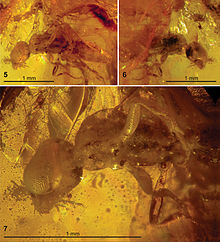New Jersey Amber

New Jersey amber is the name for a type of amber mainly found in the Raritan Formation ( Turonium ) in the state of New Jersey (USA).
Occurrence
The amber was and is mainly found in various outcrops (mostly clay pits and in lignite ) of the Raritan in New Jersey, more recently especially near Sayreville and East Brunsweak. To a small extent, amber with identical chemical and physical properties and presumably the same genesis is also known from the Magothy Formation ( Santonium ). Amber from these Upper Cretaceous formations is found in small quantities in other areas in the northeastern United States. In Anglo-Saxon literature, the term Raritan is also used as a collective name for this amber deposit .
Age and botanical origin
It is assumed that the amber lies on the primary deposit and is therefore of the same age as the matrix in which it is found (approx. 85 to 93 million years). Investigations using gas chromatography with mass spectrometry coupling suggest that the resin comes from trees from the conifer family Cupressaceae . Earlier assignments to the Araucariaceae are mostly discarded in more recent literature.
use
New Jersey amber has been known since the first half of the 19th century. Although ancient reports suggest that amber was found in very large quantities, particularly at the turn of the 19th and 20th centuries, it appears that it has never been used commercially. The current find opportunities are comparatively small. The amber is relatively brittle, so that it is not suitable for making jewelry. Pieces of scientific merit are usually embedded in epoxy resin due to the fragile nature of the material .
Inclusions
The first written evidence of organic inclusions in this fossil resin dates back to 1821. The systematic scientific treatment of the rich flora and fauna in New Jersey amber did not begin until the beginning of the 20th century. Since then, more than 250 species of Hexapoda from 15 orders have been discovered. An extraordinary find is a well-preserved specimen of the tardigrade (Tardigrada) Milphthal swolenskyi , which shows great similarities with the recent species Milgiene tardigradum , which is known for its cryptobiotic way of life. Plant remains are not uncommon; Furthermore, the fruiting body of the fungus Archaeomarasmius leggetti from the family of knight relatives (Tricholamataceae) was identified.
Trivia
According to contemporary reports, workers found amber in clay pits in the region in the 19th century in such large quantities that they collected it as fuel and lit it in barrels on winter days to warm themselves by the fire.
literature
The information in this article is essentially taken from the following sources:
- Grimaldi & Nascimbene: Raritan (New Jersey) Amber. In: Biodiversity of fossils in amber from the major world deposits. D. Penney, Manchester (UK) 2010, pp. 167-191. ISBN 978-0-9558636-4-6 .
- Petty C. Rice: Amber - The Golden Gem of the Ages. New York 1987, ISBN 1-4259-3849-3 .
- George O. Poinar, Jr .: Life in Amber . Stanford (Cal.) 1992, ISBN 0-8047-2001-0 ( limited preview in Google Book Search).